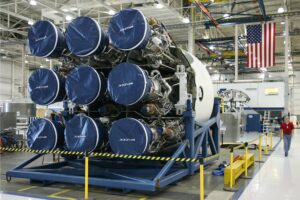China May Not Need Western Technology Much Longer

source: Bloomberg.com, contributed by Artemus FAN Bill Amshey & Founder Bob Wallace | Image: pexels.com
The latest ranking of global spending on research and development has US tech companies on top and Chinese rivals on the rise.
Western countries have become increasingly wary of sharing technology with China, with the US and Netherlands recently imposing new restrictions on exports of semiconductors and the equipment used to make them. Meanwhile, Chinese companies are rising up the list of the world’s biggest spenders on research and development — a sign that perhaps they won’t need that Western technology much longer.
When I last compiled one of these lists five years ago, mobile infrastructure and device maker Huawei Investment & Holding Co. was in sixth place behind Microsoft, just as it is here, but it was the only Chinese company in the global top 25. It has been joined by TikTok owner ByteDance Ltd., WeChat owner and gaming giant Tencent Holdings Ltd. and e-commerce, payments and cloud-computing purveyor Alibaba Group Holding Ltd. The $14.6 billion figure for ByteDance is for 2021 and comes from a report the privately held company shared with employees last year, which the Wall Street Journal reported on in October. The Information reported on April 1 that ByteDance has told investors revenue rose 30% in 2022, so I would guess its 2022 R&D spending would rank even higher.
All the other numbers above come from publicly released financial statements, but companies have a fair amount of leeway in determining what constitutes R&D spending. Amazon.com Inc. doesn’t even report it, instead including a line in its income statements for “technology and content” that is probably mostly R&D but is opaque. In 2017 and 2018, the US Securities and Exchange Commission sent a series of letters to Amazon pressing it to report R&D as other companies do but backed down after Amazon argued that “our business model encourages the simultaneous research, design, development, and maintenance of both new and existing products and services” and that separating out just the R&D would be hard to do and meaningless to its investors.
It is possible that some other privately held company is spending more on R&D than No. 25 Bayerische Motoren Werke AG’s $7.5 billion, but unlikely. Huawei is employee-owned but releases an annual report, as does foundation-and-family-owned German auto-parts maker Robert Bosch GmbH, which spent $6.7 billion in 2022, good for 34th place. (Like other European and Japanese companies, it would be higher in a dollar-denominated ranking like this if the euro and yen were stronger.) Among the world’s other biggest private companies, most don’t seem to report their R&D spending, but most also don’t fit the profile of a big R&D spender.
That profile involves being in tech, pharmaceuticals or auto manufacturing. This has been true for decades. The number of tech companies has grown, with relative newcomers Amazon, Google parent Alphabet Inc. and Facebook parent Meta Platforms Inc. now occupying the top three spots and most of the Chinese companies new to the list. But when I found a top 20 ranking from 2004, compiled by Booz Allen Hamilton from Bloomberg data, I was struck by how many familiar names it contained.
Of the companies listed here that aren’t in the current top 25, all but one remain in the top 50, with Matsushita Electric successor Panasonic Holdings 61st. The combined R&D spending of Mercedes-Benz Group AG and Stellantis NV, the products (with the addition of Fiat) of the 2007 DaimlerChrysler breakup, would put it in 16th place. Also, if you’re wondering where semiconductor industry leader Taiwan Semiconductor Manufacturing Co. fits in to all this, it comes in 41st in R&D but fourth in capital spending, behind only Amazon, Samsung Electronics and Saudi Arabian Oil Co.
One thing that has changed since 2004 is how much further ahead of the pack the top spenders are. Leaving Amazon and its unique accounting aside, current No. 2 Alphabet is spending more than four times as much on R&D as No. 20 Bristol-Myers Squibb. In 2004, No. 1 Microsoft spent less than twice as much as No. 20 Merck.
Most of the top automakers are spending similar amounts on R&D, adjusted for inflation, as in 2004. The exceptions are Volkswagen AG and BMW, which are spending substantially more, and Ford Motor Co., which is spending a third less. Pharma companies are generally spending a lot more, but the most spectacular increases have been in tech, among what I guess we should start calling the MAAAM companies (others have suggested MAMAA, but they’re wrong), for Microsoft Corp., Apple Inc., Amazon, Alphabet and Meta. With the exception of Apple, these companies’ R&D spending is going toward inventing and improving not so much physical products as algorithms, artificial-intelligence systems and the like — which goes for Chinese counterparts ByteDance, Tencent and Alibaba as well. In the US, most of these companies have been announcing big layoffs lately, but the effect on their R&D spending is so far barely discernible.
For the companies themselves, these huge increases in R&D spending could be of limited value. A 2020 study by accounting scholars from the University of Washington and University of Texas found that while there was once a strong relationship between R&D expenditure and future profitability, it has become much weaker since the 1990s. For national and regional economies, the evidence still points to a payoff in terms of productivity gains and growth, although it’s too early to know whether this will be true for the R&D boom of the past few years. If it is, it looks as if the US and China are best positioned to benefit.
